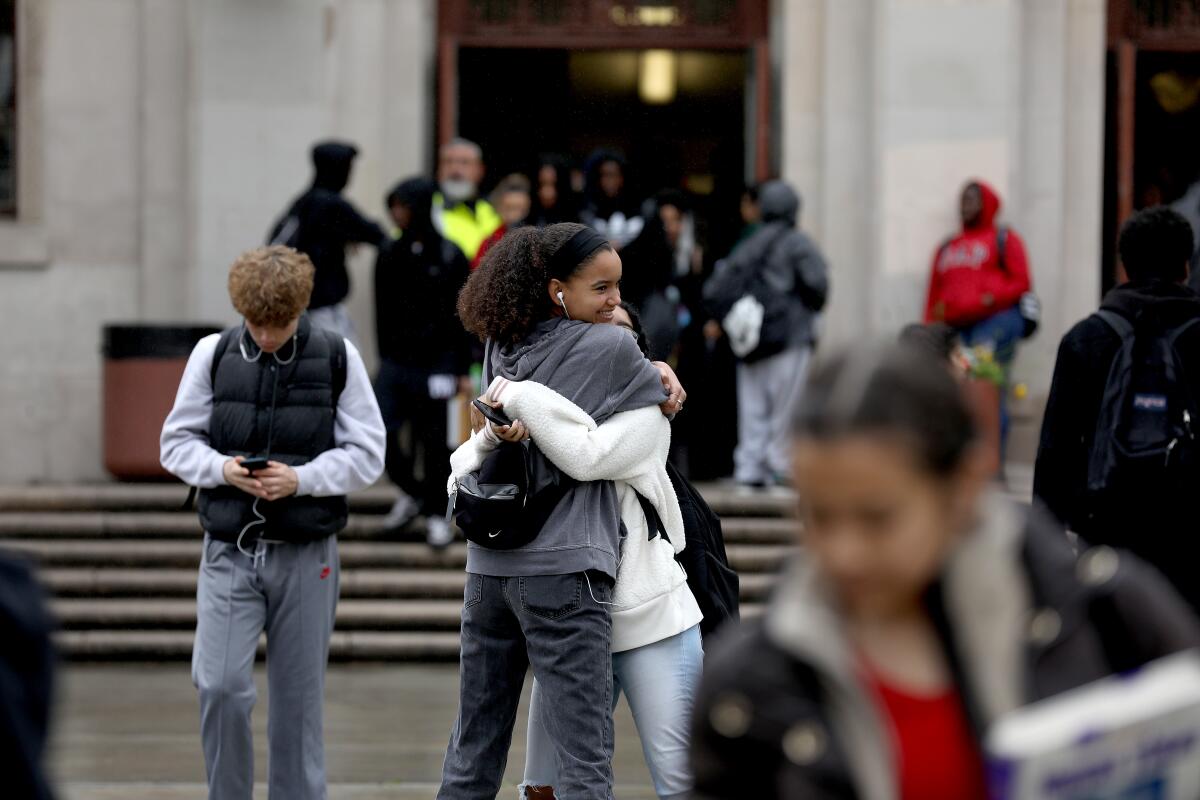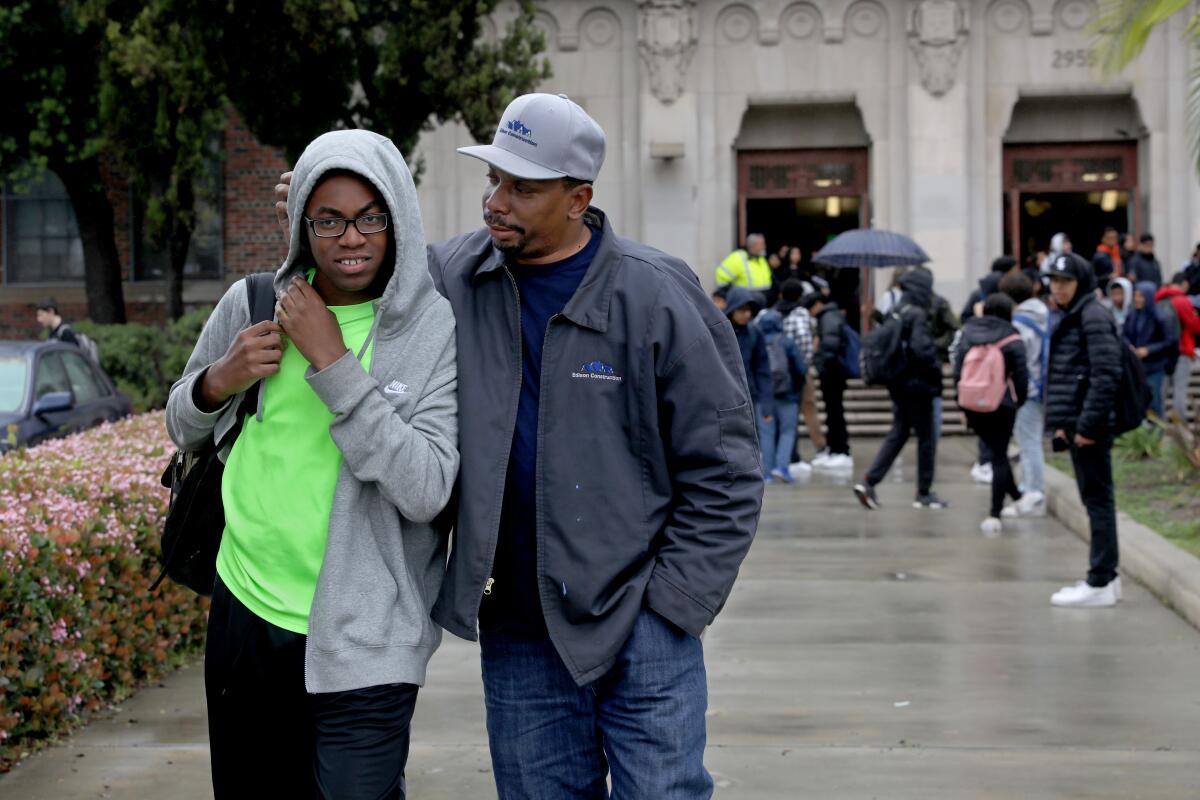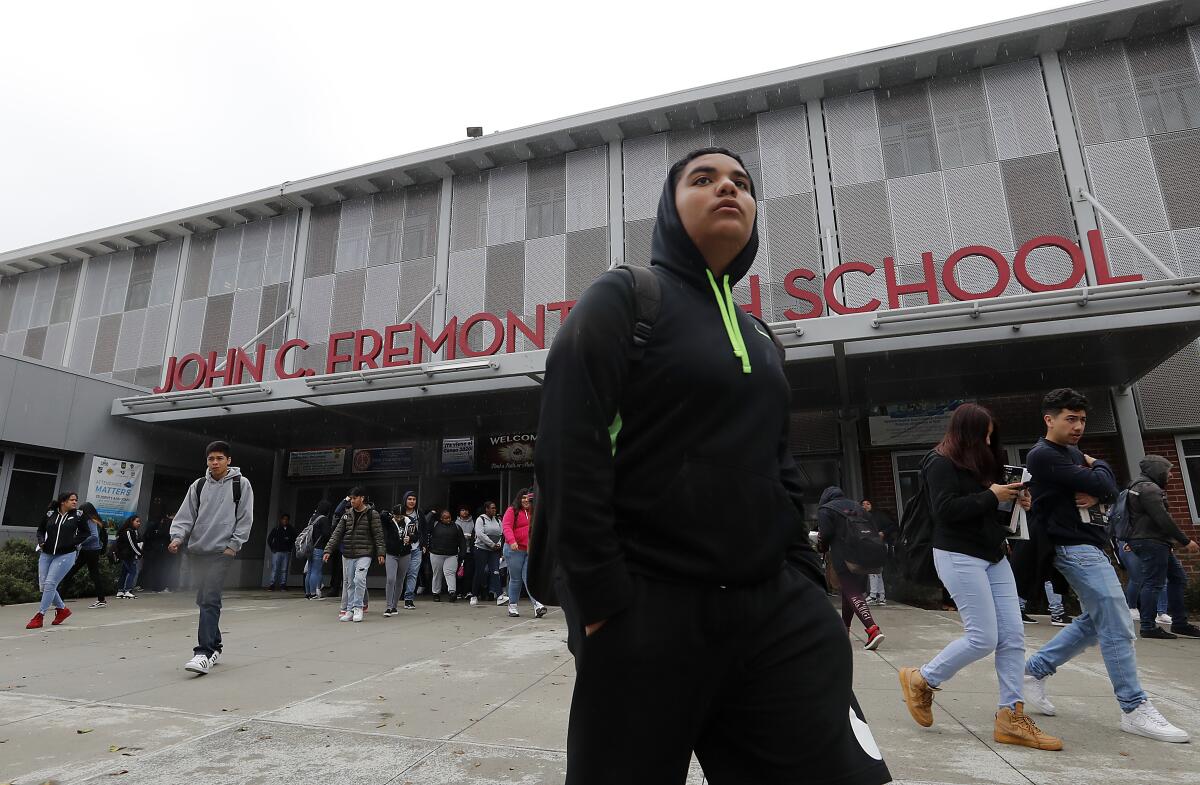Millions affected as schools across U.S close to combat spread of coronavirus

- Share via
Major school districts throughout California, including Los Angeles Unified, announced shutdowns Friday, joining at least `12 states that have ordered complete closures amid escalating attempts to slow the spread of the coronavirus.
Los Angeles, the nation’s second-largest school system, will shut down its 900 campuses serving more than 670,000 students beginning Monday.
The closure initially is scheduled to last two weeks, but a firm reopen date will depend on the status of the outbreak, which President Trump declared a national emergency on Friday.
“The public health crisis created by the coronavirus is not something any of us could have reasonably expected to happen, and we are in uncharted waters as we work to prevent the spread of the illness,” LAUSD Supt. Austin Beutner said Friday while announcing the closures.

California’s five largest public school districts, including Fresno, Long Beach and Elk Grove, will pause classes. Although the state Department of Education does not have an exact number, closures will be in effect Monday at more than 100 districts and will affect more than 2 million students. All schools are closed in the counties of Marin, Monterey, Sacramento, Santa Barbara, Santa Clara, Solano and Ventura. This comes on top of widespread actions by most state universities, including most of the University of California, to cancel in-person classes and move to online learning.
Friday afternoon the influential California Teachers Assn. called on Gov. Gavin Newsom to close all state schools.
Catholic schools in Los Angeles, Ventura and Santa Barbara counties will close on Tuesday and nearly 75,000 students will shift to remote learning through at least March 31, the Archdiocese of Los Angeles announced.
At least 12 states — Alabama, Illinois, Louisiana, Maryland, Michigan, New Mexico, Ohio, Oregon, Virginia, Washington, West Virginia, and Wisconsin — ordered all schools closed.
Officials throughout the country have struggled with the monumental decision to upend the routines of millions of families and seriously disrupt the education system at a critical time of instruction as schools give annual achievement tests, older students take Advanced Placement exams, high schoolers visit colleges and seniors complete credits needed for graduation.
The closures could disproportionately affect children from poor and low-income families, many of whom receive their weekday breakfast and lunch and, in some cases, dinner on campus. LAUSD enrolls about half a million students in kindergarten through 12th grade, some 80% of whom rely on free or reduced-price lunches and 18,000 of whom are homeless.

Parents rely on schools to provide childcare while they work — including first responders, nurses, doctors and other emergency personnel who are likely to be needed to deal with the community medical crisis.
“California has now entered a critical new phase in the fight to stop the spread of the COVID-19 pandemic,” said a joint statement by Beutner and Cindy Marten, superintendent of the San Diego Unified School District. “There is evidence the virus is already present in the communities we serve, and our efforts now must be aimed at preventing its spread. We believe closing the state’s two largest school districts will make an important contribution to this effort.”
Crystal Ellis, 34, heard the news before she went to pick up her son at Raymond Elementary School in South Los Angeles as a light drizzle came down. She held a white package and an iPad that the school asked her to pick up for her 11-year-old son.
“It’s a little bit scary because I don’t know what’s going to happen,” she said.
School leaders throughout the country say they are acting with an abundance of caution although the Centers for Disease Control and Prevention has advised that short-term school closures of two to four weeks may not do much to stem the spread of the disease.
Her head shaking as she spoke Friday, veteran L.A. school board member and former state lawmaker Jackie Goldberg called the closures “probably the most difficult decision any of us on the board have had to make because it affects so many people, and it affects so many children, and it affects so many people who have jobs that they are fearful of losing if they have childcare issues.”
A key element of the Los Angeles plan for the closures is to open 40 family resource centers throughout the vast school system. The centers, which will open Wednesday, will provide childcare, packaged meals and educational activities.
As a public health precaution, all center visitors will have their temperatures taken with forehead thermometers upon arrival, and all students will be directed to wash their hands. The centers will be staffed by district employees, who will receive extra pay, on a voluntary basis.
The facilities will operate from 6 a.m. to 6 p.m. and likely will be located at schools, Beutner said. He added that he hoped local transit agencies would provide free rides to and from the centers, but nothing has been worked out so far.
Beutner said a list of the centers will be made public before Monday.
In addition, the Los Angeles district will offer televised and online lessons in an attempt to help families. School district employees will continue to be paid, even if not directly involved in working with students.
The extraordinary closures are the first of this scale since the 1994 Northridge earthquake. All of the district’s then 640 schools were closed immediately following the temblor, and most reopened eight days later. About a dozen campuses were closed for three weeks, and three campuses were closed for six weeks.
The move to close schools amid the coronavirus outbreak came amid mounting pressure for LAUSD to take more aggressive action.
Teachers union president Alex Caputo-Pearl, who called on the district Thursday night to shutter campuses, said schools were being forced to “choose between two unacceptable alternatives, which is choosing to keep schools open in a dangerous situation or close schools and fear for the lack of a social safety net that schools end up having to provide too much.”
A central challenge faced by the district is the continuation of academic work during a shutdown that could last for two weeks or more.
L.A. Unified is trying to address three hurdles: a lack of broadband access for students, a lack of computers at home, and teachers and students who are underprepared to switch to a non-classroom format.
In a Monday letter to Gov. Gavin Newsom, Beutner said that the district has about 330,000 computers available for 480,000 K-12 students. The district, Beutner said, would “need an additional 150,000 devices to make sure all students can continue to learn if their schools are closed.”
However, it isn’t clear that all these computers could be sent home with students or that they are the correct devices for the task at hand. An iPad without a keyboard, for example, would work for a student film project, but not so well for an essay.
Beutner has requested $50 million from the state for additional computers, but no immediate relief appears to be in sight. In the meantime, he has authorized the use of $10 million to purchase 50,000 additional devices, which should be available in several days, he said.
Beutner had the power to authorize this purchase, without going through the normal, lengthy bidding process, by virtue of emergency powers granted this week by the Board of Education.
In the meantime, the plan was for schools to distribute computer devices Friday for students who need them.
But having computers is only part of the challenge. Many families lack the broadband access needed to connect online to lessons and assignments. Beutner on Monday wrote to local carriers requesting that they place free hotspots in low-income communities.
Charter Communications announced that, beginning Monday, it will offer 60 days of free Spectrum broadband and Wi-Fi access to households with K-12 or college students who do not already have a Spectrum broadband subscription. Installation fees will be waived for these households and the company also plans to open Wi-Fi hotspots across its footprint for public use, as of Monday.
In Los Angeles, some parents reacted to the news of the closures with apprehension.
At a South L.A. laundromat on Friday, Adela Hernandez, 35, wondered how she and her husband would manage the education of their 10-year-old son, who attends West Vernon Elementary School, at home, where they don’t have the internet.
“Maybe I’ll ask the neighbor if they can give us access,” she said. “I’ll have to maybe pay her.”
Times were already getting hard. Hernandez said she’s bringing in less money working at a clothing company because her hours at work were recently slashed.
Outside Augustus Hawkins High School in South L.A., Nancy Ramirez, 34, said she worries how her 18- and 11-year-old daughters will keep up because they do not have computers at home. Her older daughter, who declined to give her name, said she planned to use her cellphone to do her school work or go to a relative’s house to use the internet.
Ramirez, who drives for Uber during the day, said she will probably stay with her daughters during the day and drive at night. Her ex-husband helps care for the girls, but she fears he could lose his job because he works for a China-based company.
“We gotta work,” she said. “We need money to pay rent and bills.”
More to Read
Sign up for Essential California
The most important California stories and recommendations in your inbox every morning.
You may occasionally receive promotional content from the Los Angeles Times.














